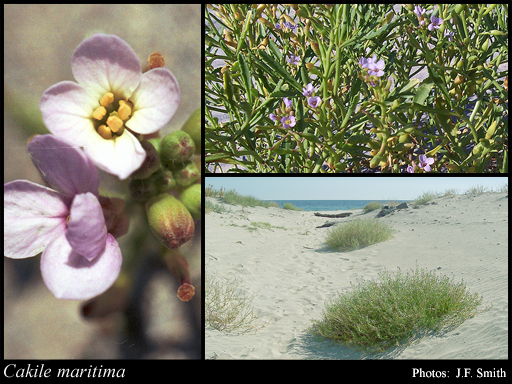- Reference
- Fl.Carniol. Ed.2, 2:35 (1772)
- Conservation Code
- Not threatened
- Naturalised Status
- Alien to Western Australia
- Name Status
- Current
Succulent, decumbent to ascending annual, herb, 0.2-0.5 m high. Fl. white-pink-purple, Jan to Dec. Beach sand. Seashores.

Distribution
- IBRA Regions
- Esperance Plains, Geraldton Sandplains, Hampton, Jarrah Forest, Swan Coastal Plain, Warren, Yalgoo.
- IBRA Subregions
- Edel, Fitzgerald, Geraldton Hills, Hampton, Lesueur Sandplain, Perth, Recherche, Southern Jarrah Forest, Warren.
- IMCRA Regions
- Abrolhos Islands, Central West Coast, Eucla, Leeuwin-Naturaliste, Shark Bay, WA South Coast, Zuytdorp.
- Local Government Areas (LGAs)
- Albany, Augusta Margaret River, Bunbury, Busselton, Cambridge, Capel, Carnarvon, Claremont, Cockburn, Cottesloe, Dandaragan, Denmark, Dundas, Esperance, Fremantle, Greater Geraldton, Harvey, Irwin, Jerramungup, Joondalup, Mandurah, Manjimup, Melville, Murray, Ravensthorpe, Rockingham, Shark Bay.
Management Notes (for the Swan NRM Region)
Alternative Names. European Sea Rocket.
General Biology. Growth form. Herb. Life form. Annual. Reproduction. Seed. Dispersal. Wind, sea water, ship ballasts, tides, sand transport. Seedbank persistence. 2+ years.
Notes. brid.
Additional information. Origin. Northern Africa, temperate Europe. History of use/introduction. Ship ballast. Similar exotic species. Cakile edulenta.
Suggested method of management and control. Cakile establishes in a harsh, highly specialised environment where it displaces few native taxa. In many situations it is well established and trying to control it may not be feasible or appropriate. Assess carefully whether it is displacing native taxa or possibly having other impacts at the site prior to considering any control program. Manual removal is effective but must be done at least every 8-10 weeks. Ensure material is removed off-site, as once pods are formed, seed will often mature if plants have been uprooted. Fairly selective control can be achieved by spot spraying Logran® at 0.5 g/10 L. Wick application with 50% glyphosate or foliar spraying with 1% glyphosate provides reasonable control and can be used at flowering to reduce seed set. Read the manufacturers' labels and material safety data sheets before using herbicides. For further information consult the Australian Pesticides and Veterinary Medicines Authority to determine the status of permits for your situation or state.
Management Calendar
| Calendar Type | Jan | Feb | Mar | Apr | May | Jun | Jul | Aug | Sep | Oct | Nov | Dec | Comments |
|---|---|---|---|---|---|---|---|---|---|---|---|---|---|
| Germination | O | O | O | O | O | O | O | O | Y | Y | Y | O | Germinates after rain |
| Active Growth | O | O | O | O | O | Y | Y | Y | Y | Y | Y | O | |
| Flowering | Y | Y | Y | Y | Y | Y | Y | Y | Y | Y | Y | Y | Can flower all year |
| Fruiting | O | O | O | O | O | O | Y | Y | Y | Y | Y | Y | |
| Optimum Treatment | O | O | O | O | O | Y | Y | Y | Y | Y | Y | O |
Legend: Y = Yes, regularly, O = Occasionally, U = Uncertain, referred by others but not confirmed.
References
- Barbour, M.G. (1970) Germination and early growth of the strand plant Cakile maritima. Bulletin of the Torrey Botanical Club, 97 (1): 13-22.
- Bock, C.H. (2008) The effect of Alternaria brassicicola infection on the reproductive fitness of the naturally occurring littoral ruderals Cakile maritima and C. edentula. Australasian Plant Pathology, 37 (6): 569–580.
- Brown, K. & Brooks, K. (2002) Bushland Weeds: A Practical Guide to their Management. Environmental Weeds Action Network, Greenwood.
- Cordazzo, C.V. (2006) Seed characteristics and dispersal of dimorphic fruit segments of Cakile maritima Scopoli (Brassicaceae) population of southern Brazilian coastal dunes. Revista Brasil, 29 (2): 259-265.
- Davy, A.J., Scott, R. & Cordazzo, C.V. (2006) Biological flora of the British Isles: Cakile maritima Scop. Journal of Ecology, 94 (3): 695-711.
- Debez, A., Hamed, K.B., Grignom, C. & Abdelly, C. (2004) Salinity effects on germination, growth and seed production of the halophyte Cakile maritima. Plant and Soil, 262: 179-189.
- Debeza, A., Saadaouia, D., Ramanib, B., Ouerghia, Z., Koyroc, H., Huchzermeyerb, B. & Abdelly, C. (2006) Leaf H+-ATPase activity and photosynthetic capacity of Cakile maritima under increasing salinity. Environmental and Experimental Botany, 57 (3): 285-295.
- Gandour, M., Hessini, K. & Abdelly, C. (2008) Understanding the population genetic structure of coastal species (Cakile maritima): seed dispersal and the role of sea currents in determining population structure. Genetics Research, 90: 167-178.
- Hussey, B.M.J., Keighery, G.J., Dodd, J., Lloyd, S.G. & Cousens, R.D. (2007) Western Weeds. A guide to the weeds of Western Australia. 2nd Edition. The Plant Protection Society of Western Australia, Victoria Park.
- Knapp, J.J. (2004) California Invasive Plant Inventory Assesment Form: Cakile maritima Scop. Californian Invasive Plant Council, California. URL: http://www.cal-ipc.org/ip/management/plant_profiles/Cakile_maritima.php - Accessed April 2010.
- Maun, M.A. & Payne, A.M. (1989) Fruit and seed polymorphism and its relation to seedling growth in the genus Cakile. Canadian Journal of Botany, 67: 2743-2750.
- Moore, C.B. & Moore, J.H. (2002) Herbiguide, the pesticide expert on a disk. Herbiguide, PO Box 44 Albany, Western Australia, 6330.
- Rodman, J.E. (1986) Introduction, establishment and replacement of sea-rockets (Cakile, Cruciferae) in Australia. Journal of Biogeography, 13: 159-171.
- Sauer, J.D. (1988) Plant migration: The dynamics of geographic patterning in seed plant species. University of California Press, Berkeley. URL: http://ark.cdlib.org/ark:/13030/ft196n99v8/.
- Swarbrick, J.T. & Skarratt, D.B. (1994) The bushweed 2 database of environmental weeds in Australia. The University of Queensland, Gatton College.
- Thanos, C.A., Georghiou, K., Douma, D.J. & Marangaki, C.J. (1991) Photoinhibition of seed germination in Mediterranean maritime plants. Annals of Botany, 68: 469-475.
- USDA, ARS, National Genetic Resources Program (2009) Germplasm Resources Information Network - (GRIN). National Germplasm Resources Laboratory, Beltsville, Maryland. URL: https://npgsweb.ars-grin.gov/gringlobal/taxon/taxonomysimple.aspx - Accessed October 2009.